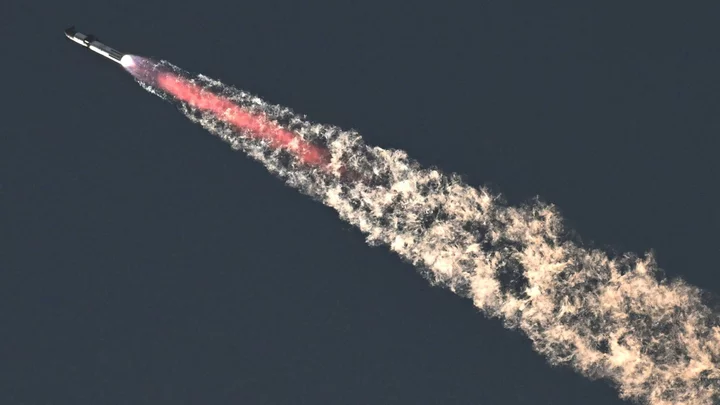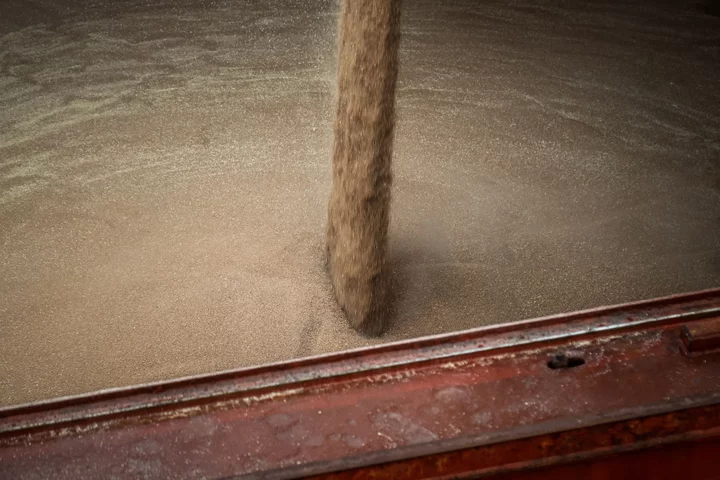SpaceX’s giant Starship rocket reached space for the first time Saturday morning but didn’t stay there for long.
The 397-foot-tall rocket successfully lifted off from SpaceX’s Starbase facility at Boca Chica, Texas, at 7:03 a.m. Central time, all 33 of its Raptor first-stage engines burning, and completed a tricky “hot staging” sequence in which the second stage’s Raptors lit before stage separation.
But after the second stage neared its own engine cutoff, at 14,990 miles an hour and 92 miles up, it vanished from the livestream broadcast on X, formerly Twitter, and from SpaceX’s telemetry.
SpaceX's Starship rocket launches from Starbase (Photo by TIMOTHY A. CLARY/AFP via Getty Images)“We think we may have lost the second stage,” SpaceX engineer and launch commentator John Insprucker said on the livestream. He added a minute or so later after getting further updates: “What we do believe right now is that the automated flight termination system on second stage appears to have triggered very late in the burn.”
Why that happened remains unclear.
Starship’s first stage saw its own “rapid unscheduled disassembly” shortly after staging—a process that had Starship’s six second-stage Raptors exhaust through a vented interstage ring before cutting the booster loose. The video showed the first stage gently falling away, with a subset of its engines reigniting, but then it exploded moments later after all of those engines blinked out.
That terminated plans to fly the booster to a controlled soft landing on the ocean to test its reusability, a key part of the Starship design for rapid reflight of this launch system.
SpaceX CEO Elon Musk adopted hot staging—a longtime feature of such Russian rockets as the Soyuz that continues to take astronauts to and from the International Space Station alongside SpaceX’s Falcon 9—as a move to boost Starship’s payload capacity after this launch vehicle’s first try at an “integrated flight test” in April.
Starship livestream moments after the second stage's telemetry stopped. (Credit: Rob Pegoraro/SpaceX)That attempt fared much worse for SpaceX. At least five Raptors failed on the first stage, the booster began flying erratically and the flight-termination system finally blew up the rocket 24 miles up to stop it from going even further out of control.
On the ground, the lack of a water-suppression system to dampen the energy of 16.7 million pounds of thrust destroyed part of the pad and sent chunks of concrete flying. The environmental damage required lengthy work to repair the pad and the addition of a water-cooled flame deflector before the US Fish and Wildlife Service and the Federal Aviation Administration signed off on a launch permit Wednesday.
The Starship effort also had a cost among SpaceX employees. A Reuters investigation published in November documented more than 600 workplace injuries—with all of those described in the report involving Starship—and revealed that SpaceX had gone years without filing any required injury reports to federal regulators.
Starship occupies a giant place in SpaceX’s plans. With what the company lists as a payload of up to 165 tons to low Earth orbit in a fully reusable configuration and 276 tons if both stages are expended, it will more than double the 70-ton capacity of SpaceX’s Falcon Heavy. And it will also comfortably exceed NASA’s Space Launch System, the moon rocket that first flew last November and that can loft almost 105 tons to low Earth orbit.
SpaceX is already counting on Starship to help deploy second- and third-generation Starlink broadband satellites in much larger numbers than its partly reusable Falcon 9 can handle.
Starship’s upper stage is also designed for orbital refueling from a second Starship, which a March 2020 SpaceX document (PDF) says will enable it to send just as much payload to the Moon or Mars.
NASA has been banking on that refueling-assisted capacity, having awarded SpaceX a $2.89 billion contract in April of 2021 to build a version of Starship’s upper stage to land astronauts on the Moon as part of its Artemis project. In May, however, the space agency granted a second, $3.4 billion lunar lander contract to Blue Origin, the space firm founded by Jeff Bezos that has staged dozens of suborbital flights but has yet to fly its New Glenn heavy-lift rocket.
Two Starship flight tests in a row ending with exploding rockets may seem light years away from the unparalleled reliability of SpaceX’s partly-reusable Falcon 9 rocket—but this second attempt should yield an immense amount of telemetry data that will inform the third try, whenever that might happen.
Musk didn’t offer an estimate of that timeframe on X after the launch but did repost a vote of confidence from NASA Administrator Bill Nelson that called the test “an opportunity to learn—then fly again.”









